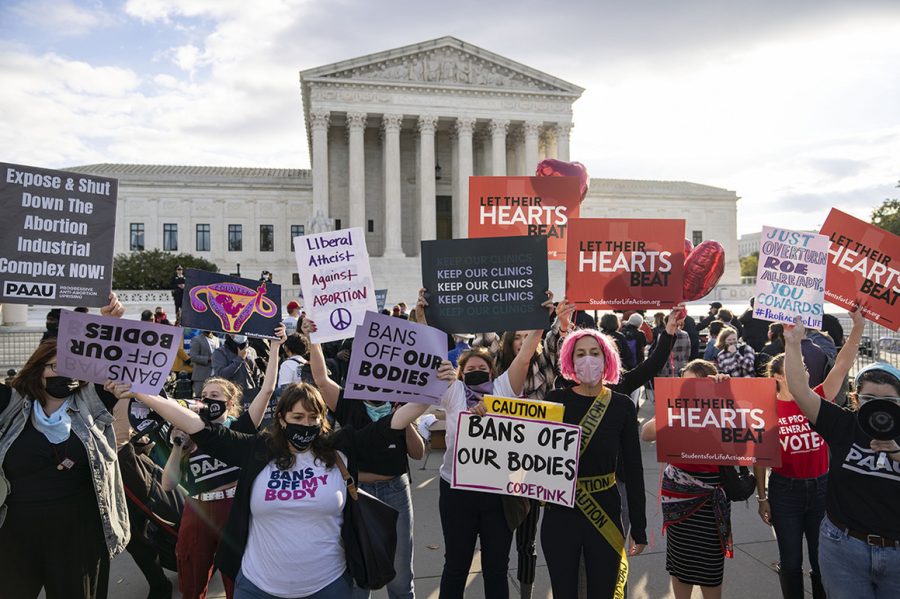Is Roe vs. Wade Constitutional?
December 20, 2022
Yes, it is Constitutional – Leah Cororve
The idea of “freedom” has defined American society and government since the nation’s founding 245 years ago. There have been many debates on what this word means, how it can be applied to our laws, and where it is granted within the Constitution. Most recently, the word “freedom” has surrounded debates on the constitutionality of abortion.
Even though the Constitution does not specifically mention the word “abortion,” access to the procedure is constitutional. The constitutionality of abortion has been up for debate ever since the Supreme Court case Roe vs. Wade. In 1973, the Supreme Court ruled that abortion was a constitutional right on the grounds of the First, Fourth, Fifth, Ninth, and Fourteenth Amendments of the Constitution. Yet the case was overturned by the Supreme Court this past summer as they ruled that the right to get an abortion was not “deeply rooted in this Nation’s history or tradition.”
While it is not explicitly stated in the Constitution, the overarching freedoms that are granted to the American people within it also grant the right to an abortion. For example, in the First Amendment, the American people are granted the right to religion, so they can practice any religion in any way they choose. In Jewish law, abortion is not only permitted, but required, if the mother’s life is at risk. Thus, if there are states in which abortion is almost completely banned and the life of a pregnant Jewish woman is potentially in danger, she would possibly be forced to carry out the pregnancy against Jewish law, compromising both freedom of religion and her own life.
The Fifth and Fourteenth Amendments emphasize that every person living in America is guaranteed the right to life. Forcing women to carry out dangerous pregnancies deprives them of this key freedom. Research conducted by “The Turnaway Study” shows that women who are denied an abortion are “more likely to experience serious complications from the end of pregnancy including eclampsia and death.” Banning abortions and thereby requiring mothers to have an unwanted child could deny them their fundamental freedoms and kill them.
The banning of abortions does not only deny women their constitutional right to “life” but to “liberty” as well. “The Turnaway Study” emphasizes that forcing women to have children has many negative ramifications, such as decreasing their financial stability, worsening their mental and physical health, and often causing them to stay with abusive partners. Without the option to get an abortion, which was secured by Roe vs. Wade, women are forced into a lifestyle that they do not want to have, causing these negative effects. Being a mother is no easy task, and it is extremely evident that when women are not granted the freedom to decide when they want to become one, they are gravely impacted.
The Supreme Court has ruled that Roe vs. Wade is unconstitutional even though the freedom to choose how and with whom you get pregnant and have children is a fundamental right. While America’s Founding Fathers are no longer alive today, they wholeheartedly believed in establishing a free nation, and the banning of abortion strips women of the necessary and constitutionally given freedom to control their bodies. Roe vs. Wade and the federal legalization of abortion are not only constitutional but are essential for America to uphold the values of “life,” and “liberty” on which it was founded.
No, it is not Constitutional – Jane Johnston
In 1970, Norma L. McCorvey falsely claimed that she had been raped to elude the strict abortion laws in Texas; however, with no evidence to back her case and her local abortion clinic shut down, she brought on a lawsuit under the alias “Jane Roe,” claiming that the state’s abortion restrictions violated her constitutional rights. The United States District Court agreed, and it was ruled that Texas’ reproductive laws violated Roe’s right to privacy under the Fourteenth Amendment and were therefore unconstitutional. Texas appealed this decision to the Supreme Court, whose controversial ruling in 1973, commonly known as Roe v. Wade, set a federal resolution on abortion, which was rightly declared unconstitutional this past June.
Regardless of what laws might be interpreted to defend abortion, the Supreme Court exceeded its constitutional authority in Roe v. Wade. Under the legal system established by the U.S. government, all legislative power in the government is vested in Congress, meaning that it is the only part of the government that can make new laws or change existing laws. The Supreme Court, on the other hand, serves as the interpreter and final arbiter of law, and therefore cannot simply act to change federal policy. The Supreme Court overstepped its Judicial power in the ruling of Roe v. Wade. In doing so, they created legislation that was not enacted by the American people’s representatives, as explained by a former associate Supreme Court Justice.
“I find nothing in the language or history of the Constitution to support [Roe v. Wade]. The Court simply fashions and announces a new constitutional right for pregnant mothers … and, with scarcely any reason or authority for its action, invests that right with sufficient substance to override most existing state abortion statutes,” said Justice Byron White and Justice William Rehnquist.
The right to abortion is not explicitly delegated to women in the United States Constitution, nor is the word abortion even mentioned, therefore those who argue for its constitutionality must then prove that it is an implied right. Many do this by pointing to the Fourteenth Amendment, which states that “No State shall deprive any person of life, liberty, or property.” Although the Fourteenth Amendment is read extremely expansively to encompass a woman’s decision whether or not to terminate her pregnancy, Roe v. Wade uses a very narrow interpretation of the word “person” to exclude unborn children. People who are pro-choice claim that banning abortion is unconstitutional because doing so might take away the woman’s right to “life” by forcing them into life-threatening pregnancies. However, abortion is legal when a mother’s life is in jeopardy in all 50 states, and even though there are some cases in which the process of childbirth will lead to death, abortions have also proven to cause major health concerns, and in extreme cases, death. Inevitably and unfortunately, some women will die because of childbirth, however, one hundred percent of abortions end with the termination of a baby, who has just as much of a constitutional right to “life” as the mother does.
Further, the argument that a constitutional right to privacy allows women to have an abortion has no real constitutional grounding. According to Justice Blackmaun when he delivered the official opinion of the Roe Court, the “right to privacy,” which allegedly defends abortion in the Constitution, is “protected by the First, Fourth, Fifth, Ninth, and Fourteenth Amendments.” However, the connection between these amendments and a constitutional right to abortion is exceptionally loose and remains unexplained by the court which presented these claims. For example, the court fails to defend how the Fourth Amendment, the “right of the people to be secure in their houses, papers, and effects, against unreasonable searches and seizures,” protects a right to abortion. It is also unsuccessful in connecting how the Fifth Amendment, that “no person shall be held to answer for a capital, or otherwise infamous crime, unless on a presentment or indictment of a Grand Jury,” relates to a right to privacy at all. This is why it is important to consider our Founding Father’s intentions when they wrote the amendments which shape our legal systems today. Without context, the meaning of the text becomes misconstrued to mean whatever best supports our individual claims. The idea that each of these amendments support such a right to privacy which defends abortion is just one court’s interpretation of vague language in the Constitution.
“As a matter of constitutional interpretation and judicial method, Roe borders on the indefensible,” says Edward Lazarus, a former law clerk to Roe’s author. “I say this as someone utterly committed to the right to choose, as someone who believes such a right has grounding elsewhere in the Constitution instead of where Roe placed it.”
The only two constitutional solutions to abortion are to either create a federal law to settle the issue or let each state decide what is appropriate based on the values of their citizens. For now, with the overturning of Roe v. Wade, the legality of abortion is left up to the individual states to regulate, as was intended by the Founding Fathers of America. However, if in the time ahead, the American people want to make abortion a federal regulation, then Congress needs to do its job and pass a federal law, rather than leaving the decision up to a panel of judges who have no authority to create legislation.
Sources used:
National Council of Jewish Women
Advancing New Standards in Reproductive Health
United States Conference of Catholic Bishops










